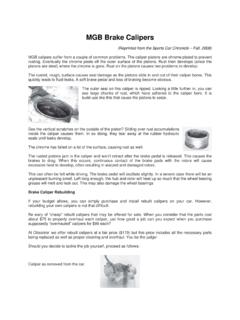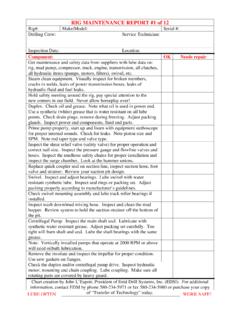Transcription of Brake Tech 01 - Powerbrake
1 Powerbrake Page 1 of 8 Brake tech #01 The final word on Brake judder and warped discs In simple terms Brake judder is experienced by the driver of a car as a pulsation through the Brake pedal and/or side-to-side vibration of the steering wheel under braking. The above symptoms can be frustrating, disconcerting and result in driver complaints about warped Brake discs. The phrase warped Brake discs is used almost universally by uninformed vehicle owners to describe the cause of Brake judder. The actual underlying causes of Brake judder are, without a doubt, the most misunderstood aspect of automotive braking. While it is possible for a Brake disc to warp or distort ( change shape) - disc distortion is responsible for relatively few Brake judder complaints in our experience.
2 The overwhelming cause of Brake judder is a condition called Disc Thickness Variation period! In other words the disc develops a lack of parallelism between its inboard and outboard friction surfaces. I say, develops because even discs that are machined to the very tightest tolerances during production can easily develop Disc Thickness Variation (hereafter referred to as: DTV) due to incorrect fitment or driver abuse. When the Brake pads are pressed up against a disc that has developed DTV they will pass over a series of thinner and thicker areas on the braking surface of the disc in rapid succession. Considering that the Brake pads are being pushed together with substantial force they will be forced down into the cavities or thinner areas only to be kicked back violently when reaching the bumps or thicker areas.
3 The frequency of this bouncing action is typically over 100 Hertz when braking from highway speeds of around 130kph. This results in pulses that are transmitted through the caliper pistons, via the Brake fluid to the driver, who experiences them as Brake Causes of DTV Once you understand the causes of DTV it becomes clear that Brake judder problems can be almost completely eradicated by following a few simple rules. So, what causes DTV? DTV can be caused by a number of factors including disc fitment errors, driver abuse and poor manufacturing processes. The causes above are mentioned in order of their likelihood of occurrence. DTV Cause No. 1: Failure to ensure that the mounting surface of the Brake disc and hub are perfectly clean prior to disc fitment.
4 One of the most common causes of DTV is the failure of the fitter to properly clean the mounting surface of the disc and the vehicle s hub. The smallest fragment of dirt or rust scale caught between the mating surface of the disc and hub is magnified as you move towards the outside diameter of the disc. This results in an unacceptable amount of axial run-out (inboard-outboard movement) at the friction surfaces of the Brake disc (the areas of the disc that come into contact with the Brake pads). To put this into perspective, the maximum axial run-out measurement that Powerbrake will accept on a newly fitted disc is (measured in the centre of the friction surface of the disc). A single spec of rust scale measuring only (50 microns) in thickness trapped between the mounting surface of the disc and the hub can easily cause the axial run-out value to exceed this tolerance!
5 Powerbrake Page 2 of 8 Once you have a Brake disc that is fitted with unacceptable run-out you have entered a downward spiral that will lead to Brake judder and irreversible disc damage over time. Every time you apply your brakes the pads will first come into contact with the disc at the point of maximum run-out. In fact, due to the fact that your Brake pads retract only fractionally when you release your brakes, excessive run-out often causes a light, continuous rubbing of the disc against the pads at the point of maximum run-out. This is happening when you are off the brakes completely! To understand what happens next we need to briefly discuss two broad categories of Brake pads. The first category of pads relies more heavily on the concept of abrasion to slow your car down.
6 In simple terms this involves the mechanical gripping and breaking off of opposing pad and disc materials at a molecular level. The materials literally wear each other away in the process. The harder material (typically the disc) will wear slower than the softer friction material of the Brake pad. The second category of pads relies more heavily on the concept of adhesion. In this case some of the pad friction material is transferred to across to the contact surface of the disc, where it forms a thin, uniform layer of friction material. Essentially you now have the friction material of the pad coming into contact with identical friction material that has been deposited on the surface of the disc. Under braking, the bonds between the friction material of the Brake pad and the friction material deposited on the disc are constantly breaking and reforming.
7 Material crosses the pad/disc interface in both directions as the molecular bonds continually break and reform. All pad formulations use a combination of both abrasion and adhesion but some pads (such as common semi-metallic formulations) rely more heavily on abrasion and others (such as many high temperature Ferro-Carbon fast-road and race formulations) rely far more heavily on adhesion. Abrasive and adhesive pads affect the formation of DTV in different ways. Back to our Brake disc that was fitted without the hub and mounting surface of the disc being carefully cleaned. Let s assume that the rust scale on the hub caused the disc to have a run-out of On many vehicles this will NOT be felt as Brake judder by the vehicle owner when he collects his vehicle from the fitment centre.
8 He drives off a happy customer. However, after a period of between 1000 and 6000 kilometres of driving the brakes begin to develop a judder, which gets progressively worse. The vehicle owner complains to the fitment centre, who assumes that the discs have warped .. ! Even the best quality discs money could buy would have developed the same Brake judder. Here s As explained above, the disc was continually coming into contact with the pads at the point of maximum run-out first. If abrasive pads were being used this area of the disc would wear down quicker than the rest of the disc surface causing DTV, which is felt as an intrusive judder. If adhesive pads were being run then the pads would have deposited more material on the initial contact point (the area of max.)
9 Run-out) than on the rest of the disc surface. Again this leads to DTV and Brake judder. (See Figure 1 and 2) Figure 1 Figure 2 Powerbrake Page 3 of 8 It gets worse! Once you have the development of DTV the surface of the disc will begin to heat unevenly. The high spots will get extremely hot compared to the rest of the disc. When the temperature around these high spots reaches 650 700 C. the cast iron in that area will change structurally and transform into a material called Cementite. Cementite is far harder than the cast iron of the unaffected parts of the disc and will therefore wear considerably less as the disc wears down with use. Cementite also has very poor heat sink properties and will therefore continue to run extremely hot resulting in the rapid spread of the Cementite formation deeper and deeper into the disc.
10 As a result the DTV will get progressively worse with time until it becomes literally unbearable to use the brakes. Depending on the pads used and the driving style of the vehicle owner this process could take 1000 6000 kilometres to develop and, NO, the initial run-out will not necessarily be felt by the driver. Hence the confusion and clinging to the concept of Brake discs warping . The disc has now entered as self-defeating spiral that will very quickly become irreversible. Disc skimming will only help if the formation of Cementite has just begun on the disc surface. Once the formation of the Cementite has spread deeper into the disc material, skimming will only remove the surface layer but the DTV (and judder) will return as the Cementite wears less than the surrounding cast iron.





